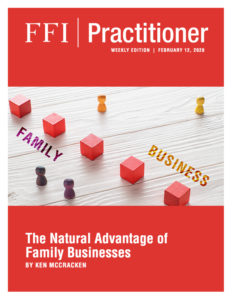
View this edition in our enhanced digital edition format with supporting visual insight and information.
With the current emphasis in the field on professionalizing family business governance, this week’s contributor, Ken McCracken, explores a different approach to governance based on what the family may already be doing successfully. In his article, Ken explains the implications of this “natural governance” and cautions advisors about immediately recommending more formal governance practices based on external standards without first understanding what the client is already doing naturally.
It seems reasonable to claim that the success of a family business is evidence that it is being well governed.
However, that success could have been achieved naturally without much by way of formal guidelines, structures, and policies.
Family businesses naturally aspire to achieve a balance among various interests as classically explained in the Three Circle Model (the stakeholders being those involved in the business, ownership, and family).1 The desire for equilibrium is not an articulated vision, mission, or purpose, but rather a desired state because it enables stakeholders to co-exist and pursue their versions of success through the family business with as few distractions as possible.
The alternative to the argument that equilibrium is a preferred state for family businesses would be that some family business systems aspire to maintain continual chaos. While many family businesses occasionally must address chaotic events, not many deliberately seek chaos as a constant state because neither the family nor its business can tolerate it for extended periods.
Natural governance in a family business is predominantly based on boundaries. For example, answers to questions like, ‘Who is family for the purpose of owning shares?’ or ‘Who is the family for the purpose of getting a job in the business?’ or ‘Who is the family for coming to dinner on Saturday?’ indicate how a family establishes various boundaries in relation to ownership, employment, and social life.
The important boundary between family and business life might be expressed as, ‘We don’t discuss business during family time’ or, ‘We don’t discuss family matters in the boardroom.’ These statements reflect an attempt to segment the domains of family and business in pursuit of a family’s idea of how to balance these competing interests.
Another family, however, might prefer a more permeable boundary between family and business, such as when a family wants its values to be manifest in the business. This choice to integrate the domains of family and business may result in employees saying, ‘You almost feel that you are part of the family.’
Boundary setting is often a random activity, meaning that the boundaries can be slightly vague. This ambiguity may tempt some individuals to ignore or reshape boundaries in pursuit of their vested interests, such as raising a family issue in the boardroom. Others, however, will attempt to police the boundaries and, in this example, they might retort, ‘Remember, we don’t discuss family matters in the boardroom.’
The ongoing process of monitoring, reshaping, and shifting boundaries is an organic characteristic of natural governance. Throughout, stakeholders are constantly striving to achieve an overall equilibrium among competing interests that enable life to go on at a tolerable level of anxiety.
Turning to decision-making, critics of family businesses often claim that they are notorious for making decisions without due process. Important discussions take place during a regular get-together or on vacation, rather than in a proper meeting. This approach is denigrated for lack of formality, accountability, and transparency, but, practically, what is the problem if this way of doing things, naturally, helps an enterprising family to achieve its version of success?
For example, some siblings and other family groups run successful businesses by operating in silos. In a family manufacturing business, this could be reflected by separate family members in charge of production, sales, and finance. Provided there is some distance between the individuals and direct communication is kept to a minimum, the business thrives through family members managing their respective silos without much interference from the others.
In this example, the family effectively resolves the anxiety of working together by simply staying out of each other’s way. Suggesting that they should hold more formal board meetings because this management practice is considered to be “normal” is practically useless given that the family clearly prefers to avoid this type of interaction. The amount of time and worry that would be invested in holding formal meetings could, in fact, turn out to be damaging to the existing form of overall governance.
Another feature of natural governance is a set of norms or values that are acknowledged by the key stakeholders as a guide when assessing other people, evaluating situations and justifying actions in relation to the business. These protocols or practices might not be written down, but that doesn’t mean they do not exist. Instead, they are imparted and enforced through innumerable day-to-day interactions at all levels, and effectively become custom and practice in the family business.
Boundaries, informal decision-making structures, and an aligned set of values are three of the four elements constituting natural governance. These elements interact and generate a set of understandings, assumptions, and expectations that is sometimes summarized as, “How we do things around here.’
The final element is the roles that people perform in order to maintain the overall equilibrium achieved through natural governance.
This might mean some individuals have to perform roles against their wishes; for example, attending a family event they would prefer to avoid, or even setting aside career aspirations in favour of a role in the family business. This example helps to illustrate that compromises and trade-offs are part of the process of creating a system of natural governance, which is not perfect. But it does not need to be perfect; it needs to be good enough to enable the key stakeholders to be willing to devote part of their lives to being in a relationship of financial interdependence with some of their relatives, which is what being in a family business means.
Nor is natural governance static. It must continually evolve in order to cope with constant changes happening inside and outside of the family and the business. Examples could include individual family members aging, entering into or leaving relationships, joining or retiring from the business, and sharing the responsibilities of ownership. Therefore, natural governance is dynamic and adapts as the needs or expectations of a family and its business develop over time.
And why does all this matter?
If advisors want to help a family business with the challenge of governance, the first challenge must be to understand what the client is already doing naturally. A new system of governance will involve changing established boundaries, decision-making structures, values and roles, and these changes must make sense to the relevant stakeholders based on their experiences of what has worked, and not worked, for them so far. For example, if the silo form of governance has worked, then the question is, can it be adapted to continue working in future?
There sometimes seems to be an indecent rush to change the natural governance in a successful family business by reference to external standards — some of which are blessed as so-called best practices, in a process that is often described as “professionalising the family business.” To the contrary, by reflecting on the natural governance that has helped them to be successful, a family and its advisors might find that the way to continue governing a successful business is to adapt what exists already.
References
1 Davis, John and Renato Tagiuri, 1982.
About the Contributor
 Ken McCracken, FFI Fellow, is a family business consultant and founder of MFBC Limited in Edinburgh, Scotland. Ken teaches a Family Business Module on the STEP Professional Postgraduate Diploma in Private Wealth Advising and in 2016, he was named the “Family Business Adviser of the Year” by the Society of Trusts and Estate Practitioners. He is a former member of the Research Applied Board for the Family Business Review and is a current member of the 2020-2021 UK/Europe Regional Advisory Committee. In 2018, Ken chaired the FFI Global Conference in London. Ken can be reached at ken@m-fbc.com.
Ken McCracken, FFI Fellow, is a family business consultant and founder of MFBC Limited in Edinburgh, Scotland. Ken teaches a Family Business Module on the STEP Professional Postgraduate Diploma in Private Wealth Advising and in 2016, he was named the “Family Business Adviser of the Year” by the Society of Trusts and Estate Practitioners. He is a former member of the Research Applied Board for the Family Business Review and is a current member of the 2020-2021 UK/Europe Regional Advisory Committee. In 2018, Ken chaired the FFI Global Conference in London. Ken can be reached at ken@m-fbc.com.

View this edition in our enhanced digital edition format with supporting visual insight and information.





